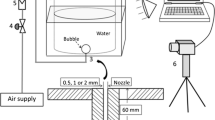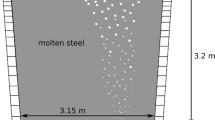Abstract
The behavior of gas discharging into melts at high velocities but still in the bubbling regime has been investigated in a laboratory modeling study for constant flow conditions. Air or helium was injected through a vertical tuyere into water, zinc-chloride, and aqueous glycerol solutions. High speed cinematography and pressure measurements in the tuyere have been carried out simultaneously. Pressure fluctuations at the injection point were monitored and correlated to the mode of bubble formation. The effects of high gas flow rates and high liquid viscosities have been examined in particular. Flow rates were employed up to 10-3 m3/s and viscosity to 0.5 Ns/m2. In order to attain a high gas momentum, the tuyere diameter was only 3 x 10-3 m. The experimental conditions and modeling liquids were chosen with special reference to the established practice of submerged gas injection to treat nonferrous slags. Such slags can be highly viscous. Bubble volume is smaller than that calculated from existing models such as those given by Davidson and Schüler10,11 due to the effect of gas momentum elongating the bubbles. On the other hand, viscosity tends to retard the bubble rise velocity, thus increasing volumes. To take elongation into account, a mathematical model is presented that assumes a prolate ellipsoidal shape of the bubbles. The unsteady potential flow equations for the liquid are solved for this case. Viscous effects are taken into account by noting that flow deviates from irrotational motion only in a thin boundary layer along the surface of the bubble. Thus, drag on the bubble can be obtained by calculating the viscous energy dissipation for potential flow past an ellipse. The time-dependent inertia coefficient for the ellipsoid is found by equating the vertical pressure increase inside and outside the bubble. This pressure change in the bubble is obtained by assuming that gas enters as a homogeneous jet and then calculating the stagnation pressure at the apex of the bubble.
Similar content being viewed by others
References
P. Halsall:Advances in Sulphide Smelting, Proc. Int. Symposium on Sulphide Smelting, H.Y. Sohn, D.B. George, and A.D. Zunkel, eds., TMS-AIME, 1983, pp. 553–82.
J. T. Woodcock:Mining and Metallurgical Practices in Australia, No. 10, The Aust. Inst, of Mining and Metallurgy, Parkville, Victoria, 1980, pp. 177–359.
J. M.Floyd and P.S.Mackey: Extraction Metallurgy ’81, IMM, 1981, pp. 345–71.
E. O. Hoefele and J.K. Brimacombe:Metall. Trans. B, 1979, vol. 10B, pp. 631–48.
M.J. McNallan and T.B. King:Metall:Trans. B, 1982, vol. 13B, pp. 165–73.
D. W. Ashman, J. W. McKelliget, and J. K. Brimacombe:Can. Met. Quart., 1981, vol. 20, pp. 387–95.
A.E. Wraith:Chem. Engng. Sci., 1971, vol. 26, pp. 1659–71.
A. A. Bustos, G. G. Richards, N. B. Gray, and J. K. Brimacombe:Metall. Trans. B, 1984, vol. 15B, pp. 77–89.
R. Clift, J. R. Grace, and M. E. Wikes:Bubbles Drops and Particles, Acad. Press, New York, NY, 1978, pp. 322–28.
J. F. Davidson and B. O. G. Schüler:Trans. Inst. Chem. Engrs., 1960, vol. 38, pp. 144–53.
J. F. Davidson and B. O. G. Schüler:Trans. Inst. Chem. Engrs., 1960, vol. 38, pp. 335–42.
R. Kumar and N. R. Kuloor:Adv. Chem. Eng., 1970, vol. 8, pp. 320–68.
D.W. Moore:J. Fluid Mech., 1963, vol. 16, pp. 161–73.
M. Nilmani: Ph.D. Thesis, Imperial College, Univ. of London, 1978.
P.E. Anagbo:Can. J. of Chem. Engng., 1982, vol. 60, pp. 220–25.
J.F. Harper:Chem. Engng. Sci., 1970, vol. 25, pp. 342–43.
H. Lamb:Hydrodynamics, 6th ed., Dour Publ., New York, NY, 1932, pp. 131–33, 147-55.
G. N. Abramovitch:The Theory of Turbulent Jets, MST Press, Cambridge, MA, 1963, p. 83.
N. Rajaratnam:Turbulent Jets, Elsevier Publ. Co., Amsterdam, 1976, p. 48.
Author information
Authors and Affiliations
Rights and permissions
About this article
Cite this article
Engh, T.A., Nilmani, M. Bubbling at high flow rates in inviscid and viscous liquids (slags). Metall Trans B 19, 83–94 (1988). https://doi.org/10.1007/BF02666494
Received:
Issue Date:
DOI: https://doi.org/10.1007/BF02666494




